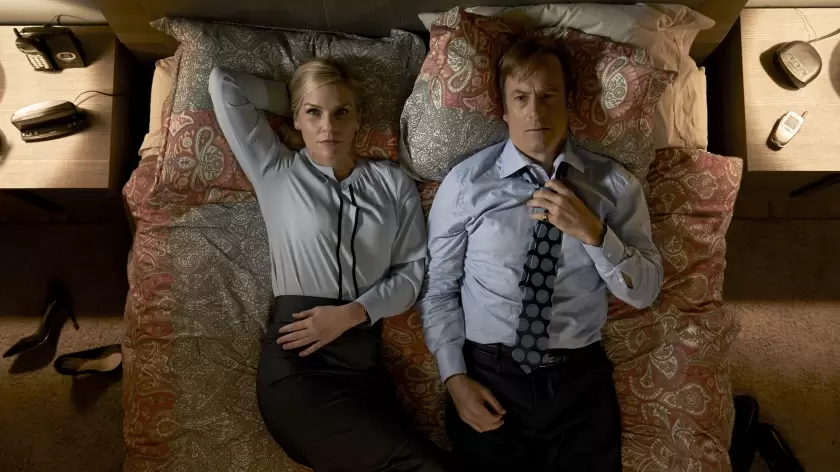|
On Monday, August 15th, 2022, the final episode of BETTER CALL SAUL aired on AMC. Over two series and twelve seasons (Six seasons each), BREAKING BAD aired 62 episodes and BETTER CALL SAUL aired 63 totaling 125. The 63rd episode of BREAKING BAD was a movie called EL CAMINO airing on Netflix that completed the Jesse Pinkman character arc from BREAKING BAD which was unresolved when that series ended. The first episode of BREAKING BAD aired on AMC on January 20, 2008. The show ran six seasons until 2013 and the prequel series, BETTER CALL SAUL, started in February of 2015 and wrapped up just last week (This show stretched its seasons out due to scheduling conflicts and the COVID-19 pandemic). Both these shows observed as a singular piece of entertainment were incredible achievements. For me, there are three aspects of these shows that I would like to discuss before this universe takes its final bow and retires as one of the greatest television experiences of all-time. The first is the cinematography, which as a film major, was probably my favorite aspect of the show. The second is the writing. Anyone can have an idea and create the initial groundwork for a television show. But being able to evolve your writing to recognize the talent at your disposal is a skill that is underappreciated. Finally, I am hoping that these two series and the one movie finish this universe completely. The law of diminishing returns kicks in when there are too many stories focused inside one universe. Ask any STAR WARS, NIGHTMARE ON ELM STREET, or MARVEL fan about this. When you have reached SHE HULK: ATTORNEY AT LAW or the BOOK of BOBA FETT levels of storytelling, you may have to recognize that your best ideas are behind you.
My favorite aspect of BETTER CALL SAUL has always been the cinematography. BETTER CALL SAUL which was made later has a more distinct visual style than BREAKING BAD. While the former show had a more profound Western influence, BETTER CALL SAUL takes inspiration from multiple genres and different types of cinematography. A few examples are the distant, wide shots inherent in gangster movies during acts of violence like seen in THE GODFATHER or MILLER’S CROSSING. Not to mention the beautiful environmental wide shots that evoke some of the most famous southwestern landscapes and desert scenery often seen in classic westerns from the 1960s to 1970s that give the environment its own defining character in support of the story. Finally, there is the noir aspect. The usage of bright lights, darkness, and spacing that was popular in the 1940s and 1950s. Watching BETTER CALL SAUL is like embracing a historical film studies class that covers a majority of the cinematography techniques of the 20th Century. The obvious influence of film on the camera work in this television show has set it apart from many of its contemporary brethren. Another AMC show that also had a wonderful cinematic feel with its bright colors, period costumes, and framing was MAD MEN. A show that embraced classic cinema techniques, the often over saturated lights and steady cams helped illuminate the beauty of the talent and their emotional performances. With SAUL, the diverse range of shots helps set the mood inside of each scene and allows each moment to stand on its own outside of the story telling. The creators also decided to play with color as all the scenes that take place in BETTER CALL SAUL after the events of BREAKING BAD take place in a haunting black and white. With the color defining the timeframe in which this part of the story occurs, the show ends on a wide two shot of Kim and Jimmy, one of them behind bars, saying goodbye for the last time. The lack of color is a perfect summation for the wreckage that remains in each of their lives. Another fantastic creative aspect of these shows is the writing. When evaluating the story from a dialogue perspective, it may come across as ordinary. But what sets these shows’ writing apart is the understanding of the characters and how their actions are believable from a human perspective. The ability to adapt and change the character and story when they don’t make sense. Not to mention that actors like Aaron Paul who played Jesse Pinkman and Rhea Seehorn who played Kim Wexler were not originally meant to be major characters in their respective shows. But because of their incredible performances, the writing adapted to making them centerpieces of each one. Understanding the talent you have and adapting the writing to account for this is an incredible feat in a creative genre that is often criticized for its rigidity. Plus, the ability of the writers to reveal new information without digging themselves into a plot hole that has no escape is a testament to note taking and open discussion. Sometimes, a collaborative writers’ room that attacks a story with an open mind can lead to entertainment nirvana. Finally, the last section of this article involves my pure opinion on the potential “future” of the BREAKING BAD universe. With two shows and a film that came as close to perfection as they have and stayed consistent for such a long period of time, I would prefer if this world were never returned to in the future. Each character’s story is complete. Vince Gilligan and Peter Gould both feel the same way as they move onto their next creative projects. It is time to appreciate the magic that these gentlemen created over a 110-to-120-hour timeframe. These shows were television in its most perfect state. There is no reason to drain more juice from that orange when it has already nourished us completely. BREAKING BAD and BETTER CALL SAUL are done. Isn’t that spectacular?
0 Comments
Leave a Reply. |
AuthorEXPERT OF SOME Archives
June 2024
|

 RSS Feed
RSS Feed